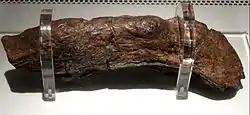Lloyds Bank coprolite
The Lloyds Bank coprolite is a large coprolite, or fossilised specimen of human faeces, recovered by the York Archaeological Trust while excavating the Viking settlement of Jórvík (present-day York) in northern England.
| Lloyds Bank coprolite | |
|---|---|
 On display at Jorvik Viking Centre | |
| Material | Palaeofaeces |
| Created | 9th century |
| Discovered | 1972 excavation, Pavement, York |
| Present location | Jorvik Viking Centre |
Description
The coprolite was found in 1972 beneath the site of what was to become the branch of Lloyds Bank on Pavement in York, and may be the largest example of fossilised human faeces (palaeofaeces) ever found,[1] measuring 20 centimetres (8 in) long and 5 centimetres (2 in) wide. Analysis of the stool has indicated that its producer subsisted largely on meat and bread whilst the presence of several hundred parasitic eggs suggests they were riddled with intestinal worms. In 1991, Andrew Jones, a York Archaeological Trust employee and palaeoscatologist, made international news with his appraisal of the item for insurance purposes: "This is the most exciting piece of excrement I've ever seen ... In its own way, it's as irreplaceable as the Crown Jewels".[2] The layers that covered the coprolite were moist and peaty. The archaeologists also preserved timber, textiles and leather from the site.[3]
Display
The specimen was put on display at the Archaeological Resource Centre, an outreach and education centre run by the York Archaeological Trust.[4] In 2003, the coprolite broke into three pieces after being dropped while being exhibited to a party of visitors, and efforts were undertaken to reconstruct it.[4] It has been displayed at Jorvik Viking Centre since 2008.
References
- Brewer, Kirstie (12 May 2016). "Paleoscatologists dig up stools 'as precious as the crown jewels'". The Guardian. Guardian News & Media Ltd. Retrieved 26 April 2020.
- Horwitz, Tony (9 September 1991). "Endangered Feces: Paleo-Scatologist Plumbs Old Privies --- It May Not Be the Lost Ark, But Then, Andrew Isn't Exactly Indiana Jones". Wall Street Journal. p. A1.
- "Coppergate Dig". Jorvik Viking Centre. Retrieved 26 April 2020.
- Simon Jeffery (6 June 2003). "Museum's broken treasure not just any old shit". The Guardian. Retrieved 5 February 2013.
Further reading
- Jones, A (1983). "A Coprolite from 6–8 Pavement". In Hall, AR; Kenward, HK; Williams, D; Greig, JRA (eds.). Environment and living conditions at two Anglo-Scandinavian sites. York: Council of British Archaeology. pp. 225–229. ISBN 0-906780-30-6.
External links
- Bone: The Man Behind the Lloyds Bank Turd - Video discussing the discovery and analysis of the coprolite
- Lloyds Bank coprolite on Instagram